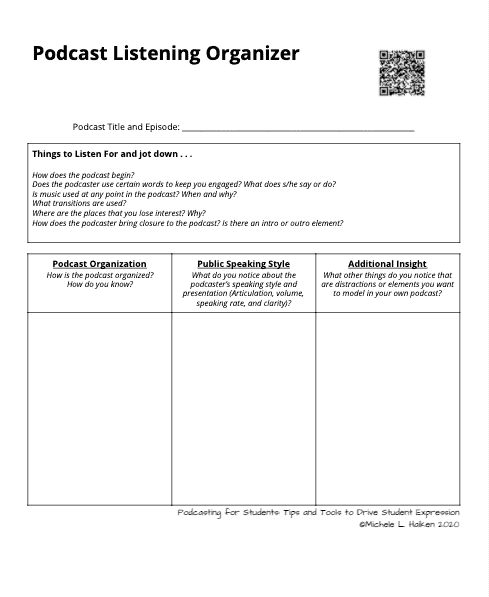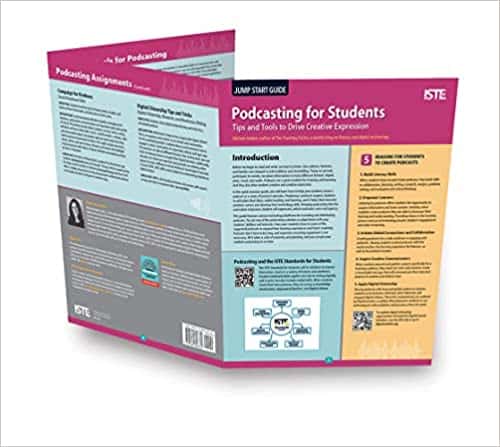Y’all know I love podcasting, both listening and creating!

Don’t miss her FREE Podcast Listening & Reflection template!
Podcasting: A Tool for Blended Learning
Guest post by Michele Haiken, Ed.D.
Storytelling is at the heart of our cultures and histories. Before we learn to read and write, we listen. In our classrooms today — whether in person, remote, or hybrid — podcasts are a great text for listening and learning.
Related: Blended Learning with Google Part 2: Storytelling
Podcasting with Students
Podcasting can also be utilized for student creation and creative expression. Producing a podcast requires students to articulate ideas, understanding, and learning. They become problem solvers and enhance their technology skills.
The ISTE Standards for Students call for students to clearly express themselves in a variety of formats and platforms. Creating podcasts requires students to research, write, and use their verbal skills to communicate a message.
When students create their own podcasts, they are acting as knowledge constructors and empowered learners. Podcasts do not need to be very long and expensive equipment is not necessary. Bringing podcasting into the classroom empowers student self-expression.
Related: How to Podcast with Students
Our job as educators today is not only to teach content area skills and knowledge, but to promote life skills like creativity and critical thinking. Podcasting is an effective medium to share knowledge and experiences. I am an avid podcast listener and use podcasts as texts to read closely and critically with my middle school students.
My foray into podcasts began with Radiolab, a show on National Public Radio hosted by Jad Abrumrad and Robert Krulwich that combines reporting and documentary on topics from science to philosophy. My ardent listening to this podcast series allowed me to deconstruct the show’s format and use it as a teaching tool in the classroom.
In essence, the podcast is presented as a five-paragraph informative essay about specific scientific inquiries: driverless cars, heroism, gender and sex chromosomes, microbiomes, and Henrietta Lacks. The engaging parts of Radiolab are not only the stories themselves, but the way the hosts present the materials with sound effects, interview excerpts, and a conversational style.
Active Listening with Podcasts

Radiolab is one style of podcasting and there are many other types of podcasting from Q & A, to conversational style (which is more like Radiolab). This fall I have binged on the Lovecraft Country Radio Podcast that coincides with HBO’s horror show Lovecraft Country providing a close reading and commentary of each episode. Like you, I listen to Kasey’s Shake Up Learning podcasts along with other awesome educator podcasts like Cult of Pedagogy and OnEducation.
You probably have some favorite podcasts yourself whether they be educational based podcasts and theater-style podcasts reminiscent of radio drama – think 1938 Orson Welles Adaptation of War of the Worlds. How you want students to present their podcasts is a decision that you and your students have to make. Maybe offer choices. By offering student choice there will be a diversity of products, students have agency and their voice is at the forefront of the finished product.
Podcasting in Every Content Area
A podcast assignment allows students to be creative communicators who use digital tools to plan and publish content. My students have created podcasts for a mystery writing unit and investigative journalism. Students are not only working on their reading and writing skills in English Language Arts but building strong communication skills, both verbally and in writing.
Podcasts are for all content areas, even science, and social studies. Creating podcasts requires students to research, write, and even revise their writing to adjust it according to the intended audience once the format and style are selected. When recording a podcast, students are not just reading aloud their writing but carefully choosing sound effects, recording interviews, and including sound bites from experts adds engaging features that draw the listener’s attention. With podcasts, it is about making the story engaging for listeners.
Podcasting Tools
As for tools, check out Audacity and GarageBand, two podcasting tools students can use for recording their podcasts. Audacity is a free online tool that allows users to record and edit digital files. GarageBand is an app for Macs that enables the user to create sound files and edit sound files. Students can also use screencast platforms to record podcasts like Screencastify. Be sure to check with your school’s technology policy to make sure the app and tools follow your school’s guidelines.
Lastly, a podcast is created to share with others for their listening engagement. Post the file or link on the school webpage, Google Classroom, or out into the world to spread the word and have listeners share feedback.
Get Michele’s Guide
Pick up a copy of this handy guide to podcasting with students! Available on Amazon
About Michele Haiken, ED.D.
Michele is the author behind The Teaching Factor, a weekly blog on all things literacy and digital technology that help strengthen student learning. A lifelong learner and middle school English for more than twenty years, she is author of New Realms for Writing: Inspire Student Expression with Digital Age Formats (ISTE, 2019), co-author of Personalized Reading: Digital Strategies and Tools to Support All Learners (ISTE, 2018), and check out ISTE Jumpstart Guide Podcasting for Students: Tips and Tools to Drive Creative Expression (ISTE, 2020).
© Shake Up Learning 2023. Unauthorized use and/or duplication of this material without express and written permission from this blog’s author and/or owner is strictly prohibited. Excerpts and links may be used, provided that full and clear credit is given to Kasey Bell and Shake Up Learning with appropriate and specific direction to the original content on ShakeUpLearning.com. See: Copyright Policy.
